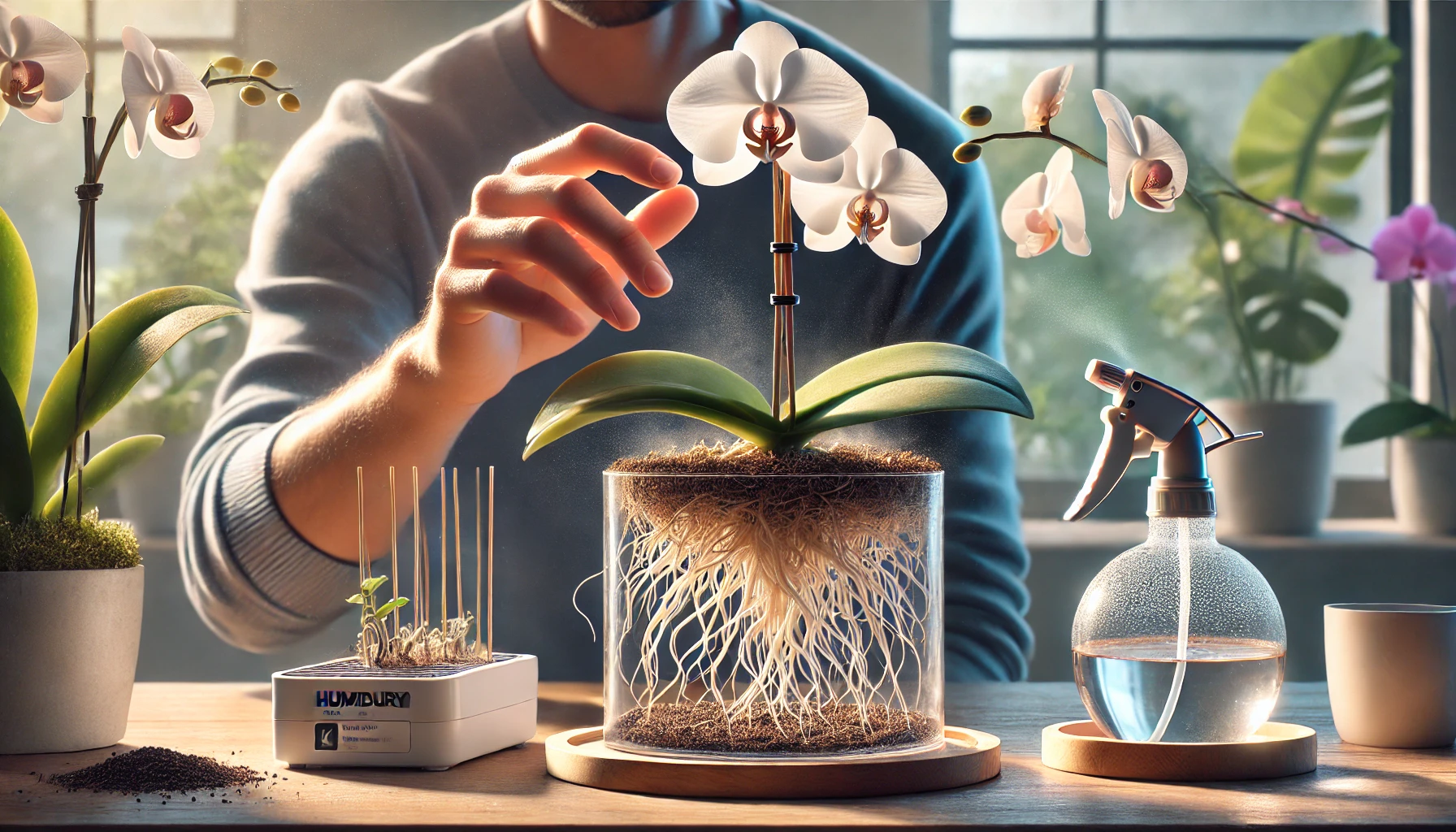Orchid roots are essential for absorbing water, nutrients, and oxygen, but they can become dry and brittle if not properly cared for. Dry roots can lead to dehydration, slow growth, and even prevent blooming. Understanding how to maintain the right moisture levels, humidity, and potting mix will help keep your orchid’s roots strong and healthy.
🌱 Why Do Orchid Roots Dry Out?
Orchids naturally grow in humid environments where they absorb moisture from the air. When grown indoors, their roots can dry out due to low humidity, infrequent watering, poor potting mix, or improper air circulation.
✔ Common Causes of Dry Orchid Roots:
- Underwatering – Not providing enough water leads to shriveled roots.
- Low humidity – Dry indoor air dehydrates roots, especially in winter.
- Improper potting mix – A mix that drains too fast can cause moisture loss.
- Poor watering technique – Watering too lightly may not reach all the roots.
- Excessive air movement – Placing orchids near fans or AC vents speeds up drying.
💡 A healthy orchid should have plump, green roots when moist and silvery-white roots when dry. If the roots are brown, crispy, or shriveled, they need more moisture.
💧 Best Watering Techniques to Keep Orchid Roots Hydrated
Proper watering is the first step in preventing root dehydration. Unlike typical houseplants, orchids do not grow in soil, so their roots need a deep soak rather than surface watering.
✔ Best Watering Methods for Hydrated Roots:
- Soak the orchid pot in room-temperature water for 5–10 minutes.
- Water in the morning so roots dry slightly before nightfall.
- Ensure water fully drains out—never let the orchid sit in standing water.
- Use rainwater or filtered water instead of hard tap water, which can cause mineral buildup.
✔ How Often to Water Based on Environment:
- Humid climate: Water every 7–10 days.
- Dry indoor air: Water every 4–6 days, or mist the roots between waterings.
- Hot weather: Increase watering frequency, especially if roots turn silvery-white quickly.
💡 If unsure when to water, check the roots—if they are completely silvery-white and slightly wrinkled, it’s time to water.
💦 Increasing Humidity to Prevent Root Dryness
Since orchids naturally absorb moisture from the air, maintaining proper humidity is key to preventing dry roots. Most orchids thrive in 50–70% humidity.
✔ Ways to Increase Humidity for Orchid Roots:
- Place orchids on a humidity tray (a shallow tray with water and pebbles).
- Use a small room humidifier to maintain consistent moisture.
- Mist lightly around the orchid in the morning to prevent dehydration.
- Group orchids together to create a moisture-rich microclimate.
💡 Never mist orchids at night—excess moisture can lead to fungal infections.
🏺 Choosing the Right Pot and Potting Mix for Moist Roots
The type of pot and potting medium you use affects how quickly orchid roots dry out.
✔ Best Orchid Pots for Moisture Control:
- Transparent plastic pots – Allow monitoring of root moisture levels.
- Clay or terracotta pots – Absorb excess water but dry out faster.
- Slotted orchid pots – Provide better air circulation while preventing over-drying.
✔ Best Potting Mix for Moist but Well-Drained Roots:
- Bark chips – Retain some moisture while allowing airflow.
- Sphagnum moss – Holds water longer, ideal for dry climates.
- Perlite & charcoal – Improve aeration and prevent excess drying.
💡 If your home is very dry, using a mix with more sphagnum moss can help retain moisture.
🛑 Common Mistakes That Lead to Dry Orchid Roots
❌ Watering too lightly – Pouring a little water doesn’t hydrate all the roots. A deep soak is better.
❌ Using the wrong potting mix – Standard potting soil suffocates orchid roots, while overly dry bark mixes may drain too fast.
❌ Ignoring humidity levels – Low humidity causes orchid roots to dehydrate even if watered properly.
❌ Placing orchids near AC vents or fans – Air circulation is important, but too much direct airflow can dry out roots too quickly.
🚑 How to Revive Dry Orchid Roots
If your orchid’s roots are already dry and shriveled, don’t worry—there are ways to rehydrate them and encourage new root growth.
✔ Steps to Rehydrate Dry Roots:
- Soak the orchid’s roots in lukewarm water for 15–20 minutes.
- Switch to a slightly more moisture-retentive potting mix (add sphagnum moss if needed).
- Increase humidity levels by using a humidity tray or room humidifier.
- Reduce exposure to strong air currents or direct sunlight.
- If roots are severely dried out, place the orchid in the Sphag and Bag method (wrapping the roots in damp sphagnum moss inside a ventilated bag) to encourage new root growth.
💡 Orchid roots that are completely dead (brown and hollow) won’t recover, but new roots will grow with proper care.
🌸 How to Maintain Healthy Orchid Roots Long-Term
To prevent dry roots in the future, follow these simple steps:
✔ Water deeply but infrequently to mimic natural rainfall.
✔ Use a humidity tray or misting to maintain moisture in dry environments.
✔ Repot orchids every 1–2 years to refresh the potting mix.
✔ Check root health regularly—plump green roots indicate good hydration.
✔ Keep orchids away from drying vents, fans, or direct sun exposure.
By following these guidelines, you can keep your orchid’s roots moist, healthy, and thriving, ensuring a strong foundation for beautiful flowers and long-lasting growth! 🌿✨
